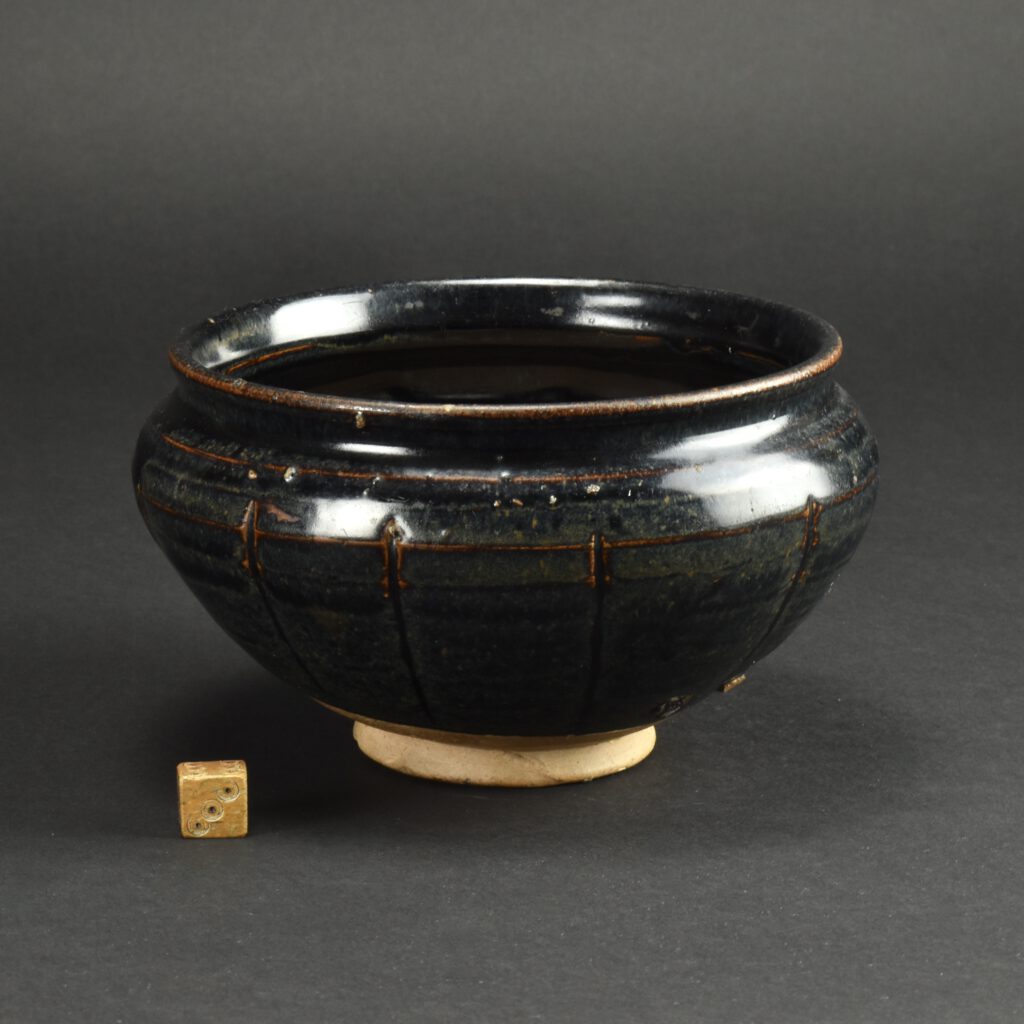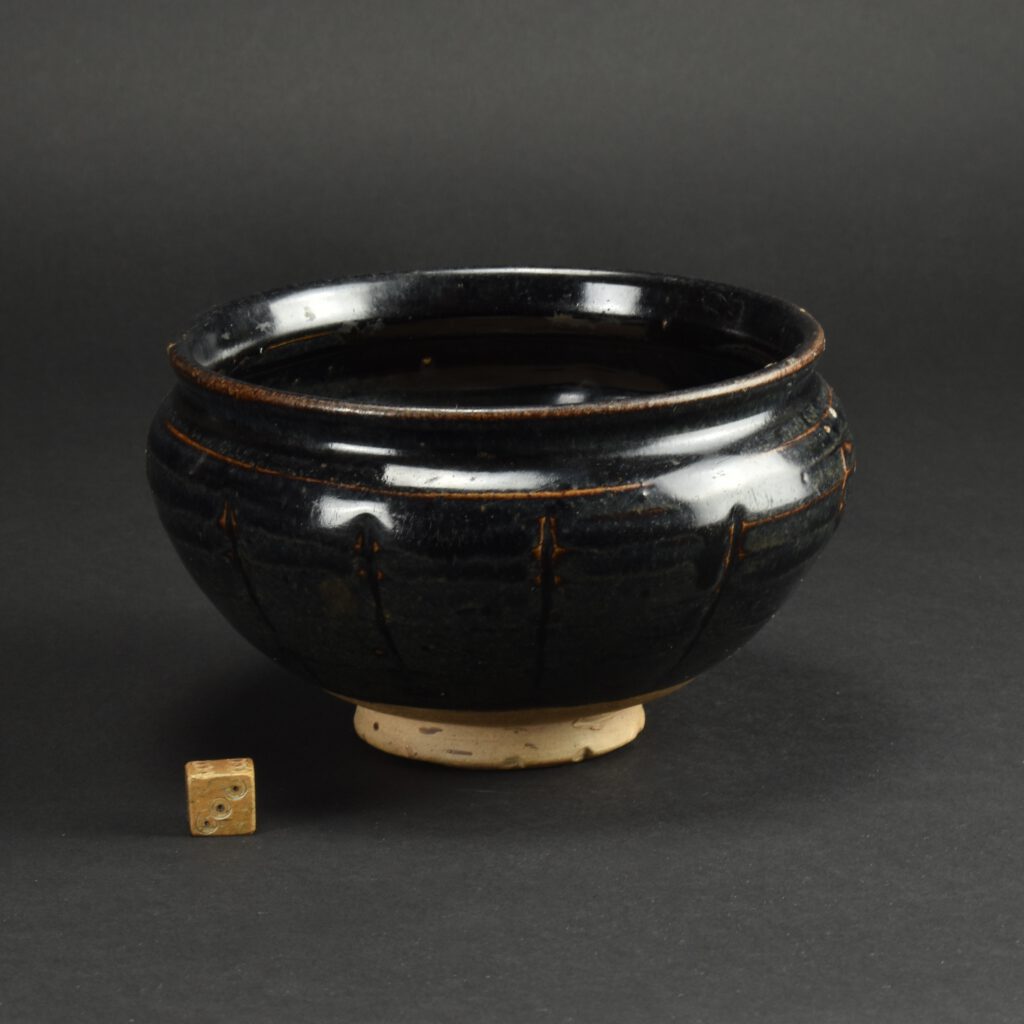
Song Dynasty or Jin Black Glazed Pottery Jar
A Cizhou Type Black Glazed Jar, North China, Jin or Song 11th or 12th Century. This small lobed hard pottery shallow jar was probably made in Hebei or Henan province. This squat shaped jar has eleven lobed of differing sizes, created by scratches incised into the glaze prior to the application of a thick of the glaze. The black glaze has been applied using a single dip into the thick iron-rich glaze. Where the glaze is thinner, on the rim and on the edges of the incised lines, it has a blackish ginger appearance. It has small mottled marks of this same colour to the glaze inside and out. The interior is unglazed, apart from accidental spots of glaze. The lower area to the exterior of the jar is unglazed, a scratch from the tool used to incised the lobed is visible. The foot is flaring to the interior, it has been cut deeply and the base is therefore recessed. It has been calculated that over thirty distinct types of decoration exist on Cizhou ware from the Song and Jin dynasties alone. Though a variety of decorations abound, the majority are carved, stamped, incised, or painted. Incising eventually developed into graffito, a common technique on Cizhou ware, in which a layer of slip is carved away to reveal the contrasting colour of the body or another layer of slip beneath the first. Painted designs frequently depict birds or flowers though a number of jars and bottles display calligraphy generally denoting their function as wine containers. Additionally, it is important to recognize Cizhou-type ware which was produced alongside Cizhou ware; the distinction being that Cizhou ware is coated in a clear glaze while Cizhou-type ware is covered in a brown or black glaze. Robert Mowry has classified and excellently written on six categories of Cizhou-type ware: monochrome glazes, partridge feather glazes, oil-spot glazes, painted decoration, ribbed decoration, and cut-glaze decoration.
SOLD
See Below For More Photographs and References.
- Condition
- A small rim chip, minor firing faults. The two dents on the footrim appear to be made during production.
- Size
- Diameter of the top rim 13 cm (5 1/8th inches).
- Provenance
- Blitz Oriental Art, Amsterdam. J. Stolk collection (Netherlands). Labels to the base. Purchased from Blitz on August 24th 1986 for f. 6,200. Photocopy of the Blitz invoice accompanies this piece.
- Stock number
- 26072
Information
Cizhou Ware
A freedom of expression exists in Cizhou ware that is unparalleled by other Song dynasty (960-1279) ceramics. This was a direct result of not being under the control of the court; consequently, the liberty to explore and experiment created an innovative range of designs full of flavour and life unique to Cizhou ware. The utilization of enamelled decorations in tones of vivid reds, yellows, and greens on occasional Cizhou pieces placed it centuries ahead of its time as this was not kosher for early court wares. The ware also displays an amazing dexterity in the sketchily incised patterns which have such a sense of carefree abandon that they appear impressionistic. Today, Cizhou ware is prized for its natural appearance which often reveals the potter’s process from the wheel’s rings, to the inner spur marks, to the unevenly glazed base.
The white stonewares of the Tang dynasty (618-906) produced two extremely influential wares; the first, Ding ware, became the official ware while the second, Cizhou, became the “popular ware” among the varying classes. It was Cizhou ware’s utilization by society that assured its continuance during political and dynastic changes which extinguished other Song wares; consequently, Cizhou ware is still produced today though the wares created during the Song dynasty are considered to possess an unrivaled spirit. Since Cizhou ware embodies a diverse range of wares not confined to a specific location, kiln complex, or style it is difficult to precisely define its characteristics.
The name Cizhou originated from the ancient area of Cizhou, encompassing a broad arc across China, which was first recorded during the Sui dynasty (581-618). However, the location constantly shifted and though the area of Cizhou is mentioned in the Tang dynasty (618-906) and Five Dynasties (906-960), each referred to an altered location. During the Song, Jin (1125-1234), Yuan (1279-1368), and partly into the Ming dynasties (1368-1644) the kiln areas of Cizhou were primarily concentrated in the northern provinces of Hebei, Henan, and Shaanxi.
Cizhou forms were particularly fashioned for household use with the most common objects being storage jars, bottles, and pillows though the rarer forms for tableware like ewers, bowls, and cups do exist. Pillows were a specialty of Cizhou ware and often display a rich variety of decoration with subjects such as children, poems, water lilies, and animals. Some of these wares bear a name mark and archaeological evidence has revealed that there were at least four workshops exclusively devoted to this enterprise; the pillows from the “Chang family” workshop continued for the longest duration. The earliest pieces of Cizhou ware are decorated in white slip and a large concentration of this ware is found at Juluxian. From this simple exterior evolved decorations which encompassed a multitude of designs, colours, and techniques.
It has been calculated that over thirty distinct types of decoration exist on Cizhou ware from the Song and Jin dynasties alone. Though a variety of decorations abound, the majority are carved, stamped, incised, or painted. Incising eventually developed into graffito, a common technique on Cizhou ware, in which a layer of slip is carved away to reveal the contrasting colour of the body or another layer of slip beneath the first. Painted designs frequently depict birds or flowers though a number of jars and bottles display calligraphy generally denoting their function as wine containers. Additionally, it is important to recognize Cizhou-type ware which was produced alongside Cizhou ware; the distinction being that Cizhou ware is coated in a clear glaze while Cizhou-type ware is covered in a brown or black glaze. Robert Mowry has classified and excellently written on six categories of Cizhou-type ware: monochrome glazes, partridge feather glazes, oil-spot glazes, painted decoration, ribbed decoration, and cut-glaze decoration.
Cizhou ware is thought to have influenced the designs found in Southeast Asia, particularly in Vietnam and Thailand. However, though the style may have drifted, the majority of Cizhou wares were produced for the domestic market; it is uncommon to discover pieces outside of China though a few remains have been uncovered in Japan, Java, Celebes, and Sarawak.









